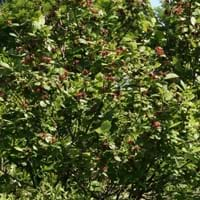Life Span
Biennial and Perennial
Perennial
Origin
Europe, Western Asia
Not Available
Types
Not Available
Calycanthus floridus floridus, Calycanthus floridus glaucus
Number of Varieties
Not Available
Habitat
waste ground, wastelands
shaded woods, Woodlands
USDA Hardiness Zone
4-9
5-8
Sunset Zone
A1, A2, A3, H1, H2, 1a, 1b, 2a, 2b, 3a, 3b, 4, 5, 6, 7, 8, 9, 10, 11, 12, 13, 14, 15, 16, 17, 18, 19, 20, 21, 22, 23, 24
3a, 3b, 4, 5, 6, 7, 8, 9, 14, 15, 16, 17, 18, 20, 21, 22
Habit
Rosette/Stemless
Spreading
Flower Color
Yellow
White, Light Yellow, Violet
Flower Color Modifier
Bicolor
Bicolor
Fruit Color
Brown, Black
Green
Leaf Color in Spring
Green
Green
Leaf Color in Summer
Green
Green, Dark Green
Leaf Color in Fall
Green
Yellow, Light Yellow, Gold
Leaf Color in Winter
Not Available
Not Available
Plant Season
Summer
Spring, Summer, Fall
Sunlight
Full Sun
Full Sun, Partial Sun, Partial shade
Growth Rate
Medium
Medium
Type of Soil
Loam
Clay, Loam, Sand
The pH of Soil
Neutral
Acidic, Neutral
Soil Drainage
Well drained
Well drained
Bloom Time
Summer
Late Spring, Early Summer
Tolerances
Drought
Drought, Shade areas
Where to Plant?
Ground, Pot
Ground
How to Plant?
Seedlings
Cuttings, Divison, Seedlings, Suckers
Plant Maintenance
Medium
Low
Watering Requirements
Average Water Needs, Do Not over Water, Keep the ground moist but not water-logged
Requires regular watering
In Summer
Lots of watering
Lots of watering
In Spring
Moderate
Moderate
In Winter
Average Water
Average Water
Soil pH
Neutral
Acidic, Neutral
Soil Type
Loam
Clay, Loam, Sand
Soil Drainage Capacity
Well drained
Well drained
Sun Exposure
Full Sun
Full Sun, Partial Sun, Partial shade
Pruning
Remove damaged leaves, Remove dead branches, Remove dead leaves
Remove damaged leaves, Remove dead branches, Remove dead flowers, Remove dead leaves
Fertilizers
All-Purpose Liquid Fertilizer
All-Purpose Liquid Fertilizer
Pests and Diseases
Aphids, Armyworm, Cutworms, Downy mildew, Pitch canker, Red blotch
Bacterial Gall, Powdery mildew
Plant Tolerance
Drought
Drought, Shade areas
Flower Petal Number
Not Available
Semi-Double
Fragrant Bark/Stem
Yes
Yes
Foliage Texture
Fine
Medium
Foliage Sheen
Matte
Glossy
Attracts
Butterflies
Birds, Insects, Not Available
Allergy
Stomach burn
Toxic if not prepared properly
Aesthetic Uses
Not Available
Beautification, Cottage Garden
Beauty Benefits
Blood purifying, Good for skin
Not Available
Environmental Uses
Air purification
Air purification
Medicinal Uses
Aphrodisiac
Antispasmodic, Cardiac, Disinfectant, Diuretic
Part of Plant Used
Root
Bark, Root
Other Uses
Food for animals, Used as a nutritious food item
Culinary use, Disinfectant, Repellent
Used As Indoor Plant
Yes
No
Used As Outdoor Plant
Yes
Yes
Garden Design
Edible, Herb, Vegetable
Feature Plant, Foundation, Mixed Border, Screening, Wind Break
Botanical Name
PASTINACA sativa
Calycanthus floridus
Common Name
Parsnip
Sweetshrub
In Hindi
चुकंदर
sweetshrub
In German
Pastinake
sweetshrub
In French
Panais
sweetshrub
In Spanish
Chirivía
sweetshrub
In Greek
Είδος δαυκίου
sweetshrub
In Portuguese
cherivia
sweetshrub
In Polish
Pasternak
sweetshrub
In Latin
parsnip
sweetshrub
Phylum
Magnoliophyta
Magnoliophyta
Class
Magnoliopsida
Magnoliopsida
Family
Apiaceae
Calycanthaceae
Clade
Angiosperms, Asterids, Eudicots
Angiosperms, Magnoliids
Tribe
Not Available
Not Available
Subfamily
Not Available
Not Available
Number of Species
Not Available
Importance of Parsnip and Sweetshrub
Want to have the most appropriate plant for your garden? You might want to know the importance of Parsnip and Sweetshrub. Basically, these two plants vary in many aspects. Compare Parsnip and Sweetshrub as they differ in many characteristics such as their life, care, benefits, facts, etc. Every gardener must at least have the slightest clue about the plants he wants to plant in his garden. Compare their benefits, which differ in many ways like facts and uses. The medicinal use of Parsnip is Aphrodisiac whereas of Sweetshrub is Antispasmodic, Cardiac, Disinfectant and Diuretic. Parsnip has beauty benefits as follows: Blood purifying and Good for skin while Sweetshrub has beauty benefits as follows: Blood purifying and Good for skin.
Compare Facts of Parsnip vs Sweetshrub
How to choose the best garden plant for your garden depending upon its facts? Here garden plant comparison will help you to solve this query. Compare the facts of Parsnip vs Sweetshrub and know which one to choose. As garden plants have benefits and other uses, allergy is also a major drawback of plants for some people. Allergic reactions of Parsnip are Stomach burn whereas of Sweetshrub have Toxic if not prepared properly respectively. Having a fruit bearing plant in your garden can be a plus point of your garden. Parsnip has no showy fruits and Sweetshrub has showy fruits. Also Parsnip is not flowering and Sweetshrub is not flowering . You can compare Parsnip and Sweetshrub facts and facts of other plants too.





